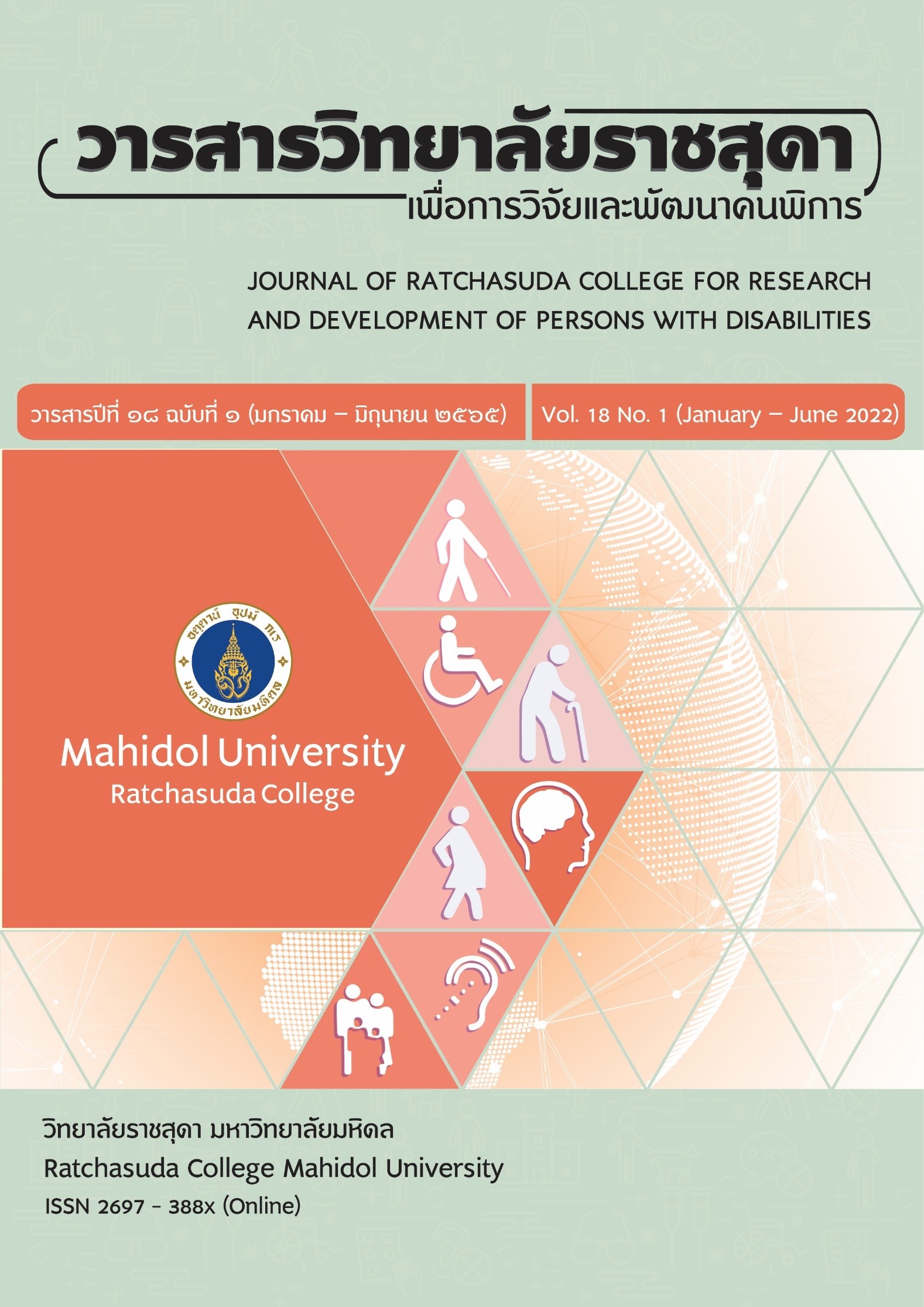Enhancing self-confidence of the student with multiple disabilities using group process
Keywords:
Multiple disabilities, Self-confidence, Group processAbstract
This research aimed to enhance the self-confidence of students with multiple disabilities using learning activities with group process and to study levels of self-confidence behavior of students with multiple disabilities, before and after the group process was applied, which is a case study of one female with multiple disabilities, age of 17, and seven deaf learners as research participants, all of whom study in secondary school for disabilities. The tools used include 1) evaluation form about self-confidence in students with multiple disabilities 2) a group process management manual 3) three group process learning activities plan, including: som tam making, waffle baking and group leadership practice. Each plan was implemented 5 times, each time lasted 50 minutes so it was 15 times in total. Each activity allows participants to act together based on their role in group membership 4) Self-confidence behavior observation record, the data was analyzed by percentage and description. The results showed that the level of self-confidence of the student with multiple disabilities increased from medium-quality level (40 percent) to highest-quality level (82.66 percent) after the experiment, classifying by aspects: having self-confidence in self-esteem, 44 percent before trial and 72 percent afterwards; having courage to express feeling through physical actions, 33.33 percent before trial and 80 percent afterwards; expressing feeling through gestures and words (sign language), 45.33 percent before trial and 80 percent afterwards. The results of the qualitative data analysis indicated that the group process enhance the self-confidence of the student with multiple disabilities as follow 1) she is aware of her self-value and express herself by using sign language such as I'm good, I can, I know. 2) she knows and understand herself, has courage to make decisions, to act, to tell (sign language) what she wants, to recognize her own abilities and to get job done as her group friends.
Downloads
References
Announcement of the ministry of education on the determination of categories and criteria for educational disabilities Act B.E. 2009. (2009). Government Gazette. 126(80), 45-47.
Bundura, A., & Walters, R. H. (1963). Social learning and personality development. New York: Holt, Rinehart and Winston.
Chaiyaphan, K. (2006). Group process. Bangkok: Odeon Store.
Chimplee, A. (2008). Self-confidence of young children through storyline activities. (Master’s thesis). Srinakharinwirot University, Bangkok, Thailand.
Department of Mental Health. (2007). Activity manual practice thinking, solve problems, develop EQ for the teen friend center. (6th ed). Nonthaburi: Printing House, Agricultural Cooperative of Thailand Ltd.
Education Management for Persons with Disabilities Act B.E. 2008. (2008). Government Gazette. 125(28), 1-13.
Erikson, E. H. (1980). Identtity and life cycle. New York: Norton.
Erikson, E. H. (1994). Identtity and life cycle. New York: Norton.
Havighurst, R. J. (1972). Developmental tasks and education. New York: David McKay.
Jambor, E. & Elliott, M. (2005). Self-esteem and coping strategies among deaf studentsJournal of Deaf Studies and Deaf Education, 10(1), 63-81.
Khemmani, T. (2002). Working group relations and teaching and learning management. Bangkok: Nissin Advertising Grove.
Kosuwan, K., & Wiriyangkun, Y. (2017). Teaching and helping people with disabilities Intellectual. Chiang Mai: Chiang Mai University.
Kradang-nga, K. (2011). Learning outcomes with group process together with learning support web containing on learning achievement and working behavior in the introductory web development group Secondary school students 2. (Master’s thesis). University Fine Arts, Bangkok, Thailand.
Maslow, A. H. (1943). A theory of human motivation. Psychological Review, 50(4), 370-396
Mohsen, A., & Esmaeil, B. (2017). The effect of group dynamics-oriented instruction on developing Iranian EFL learners’ speaking ability and willingness to communicate. Journal of Published by Canadian Center of Science and Education, 10(11), 44-59.
Office of Special Education Administration. (2013). Handbook for individual education management plans. Bangkok: Office of the Basic Education Commission.
Sittiwut, K. (2014). Using participatory learning activities and group process to construct social well being for student at Ban Numkong School, Mueang District, Nan Province. (Master’s thesis). Chiang Mai University, Chiang Mai, Thailand.
Skinner, B. F. (1974). About behaviorism. New York: Knopf.
Teeoppama, J. (2019). The effect of group process on adolescent’s self-esteem among cyberbullying (Master’s thesis). Khon Kaen University, Khon Kaen, Thailand.
Thongyoo, C. (2012). Relationships between the self-concept self-confidence and social adiustmen with life skills undergraduate students Mahasarakham University. Journal of Educational Measurement Mahasarakham University, 21(1), 83-94.
Downloads
Published
How to Cite
Issue
Section
License
Copyright (c) 2022 JOURNAL OF RATCHASUDA COLLEGE FOR RESEARCH AND DEVELOPMENT OF PERSONS WITH DISABILITIES

This work is licensed under a Creative Commons Attribution-NonCommercial-NoDerivatives 4.0 International License.
บทความที่ได้รับการตีพิมพ์เป็นลิขสิทธิ์ของวารสารสถาบันราชสุดาเพื่อการวิจัยและพัฒนาคนพิการ






